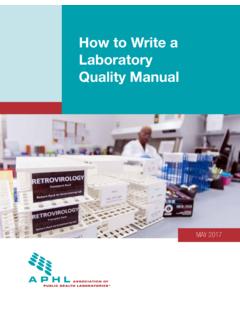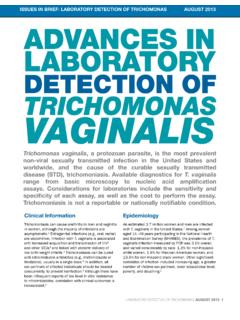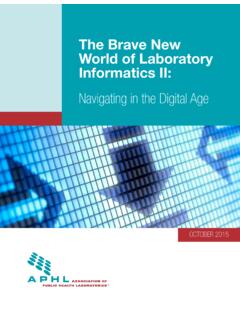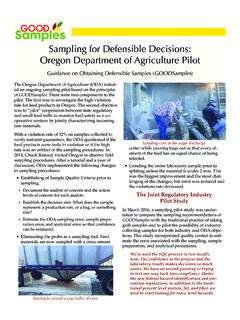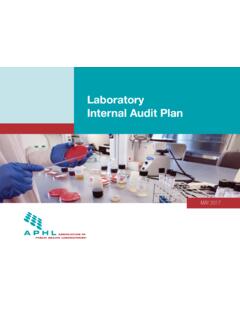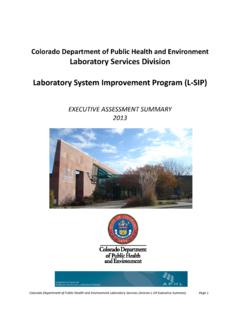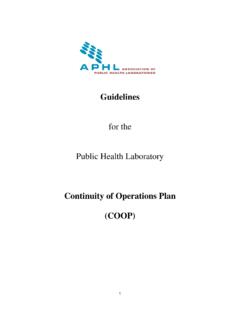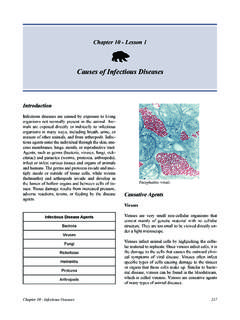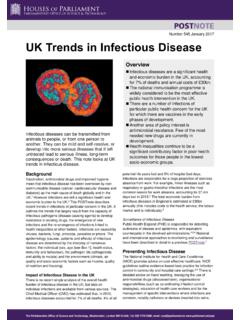Transcription of INFECTIOUS DISEASES - aphl.org
1 INFECTIOUS DISEASESLACK OF FUNDS JEOPARDIZES disease DETECTIONUNMET NEEDS Enhance the nation s ability to respond to emerging disease outbreaks by increasing capacity building at US Centers for disease Control and Prevention (CDC), develop and deploy diagnostic tests to state and local public health laboratories and provide technical assistance and training to state and local public health laboratory professionals Continued support for the Advanced Molecular Detection (AMD) and Response to INFECTIOUS disease Outbreaks Initiative to modernize and accelerate INFECTIOUS disease detection and surveillance Continued support for the Combating Antibiotic Resistant Bacteria (CARB) Initiative including increased resources for detection and surveillance of antibiotic resistant bacteria and improved integration of existing systems Increased support for the Epidemiology and Laboratory Capacity (ELC) Program to assist public health laboratories to provide capacity to identify and monitor the occurrence of INFECTIOUS DISEASES of public health importance Enhance national capacity to detect and prevent outbreaks of new INFECTIOUS DISEASES through the Emerging INFECTIOUS Program Provide HIV/AIDS funding to.
2 Enable laboratories to detect HIV infections in their earliest and most INFECTIOUS stages by supporting the most advanced testing technologies, including nucleic acid amplification testing and fourth-generation immunoassays Improve laboratory capacity to monitor and confirm HIV-2 infections Increase funding for tuberculosis laboratory infrastructure to: Implement and maintain capacity for the latest testing technology to identify tuberculosis and screen for drug resistance Develop a plan of action that will address extensively drug resistant tuberculosis (XDR-TB) to prevent it from becoming prevalent in the US Train new laboratory staff in tuberculosis testing procedures in light of a rapidly aging workforce Increase funding to address biosafety gaps in knowledge and practices within diagnostic laboratoriesPREPAREDNESS, DETECTION AND CONTROL OF INFECTIOUS DISEASESCDC funds critical laboratory improvements that allow federal and state programs to maintain early warning detection capabilities for known DISEASES and provide quick identification of unknown DISEASES .
3 Increased funding is essential to preserve existing capacity, enhance surveillance for emerging DISEASES like Ebola and Zika ASSOCIATION OF PUBLIC HEALTH LABORATORIES8515 GEORGIA AVENUE, SUITE 700, SILVER SPRING, MD 20910 | (P) | (F) 2 0 1 8 and provide improved detection and response to prevent devastating outbreaks of HIV and HCV associated with vulnerable populations such as those with epidemic levels of opiate use. An outbreak of HIV (181 cases) and HCV (167 cases) in rural Indiana could have been partially averted had there been access to laboratory testing in that community. Ongoing domestic INFECTIOUS disease threats include Carbapenem-resistant Enterobacteriaceae and other antibiotic-resistant bacteria, MERS-CoV, dengue fever, Zika virus, bacterial meningitis, chikungunya virus. Over the past few years, there have been several large, multi-state outbreaks of pertussis, measles and pertussis.
4 These vaccine preventable DISEASES are now re-emerging in children and THE ELC AND PPHFThe US Public Health System relies on both cross-cutting and disease -specific funding from the Epidemiology and Laboratory Capacity for INFECTIOUS DISEASES (ELC) Cooperative Agreement to detect and respond to INFECTIOUS disease threats. In 2010, $40 million in cross-cutting or flexible funding was added to ELC through a mandatory expenditure from the Prevention and Public Health Fund (PPHF) to strengthen epidemiology, laboratory and informatics capacity. PPHF is part of the Affordable Care Act (ACA) and the first and only mandatory public health expenditure in the US. This was the first flexible funding provided through ELC, which previously provided only categorical funding or specific dollar amounts to support detection and response for specific DISEASES . Ensuring the availability of cross-cutting funding is critical to optimizing public health surveillance and ELC dollars fund critical infrastructure that supports the public health lab system as a whole: scientists who are trained to work in various areas of the laboratory; staff liaisons between laboratory and epidemiology programs; maintenance contracts to ensure the proper performance of lab instruments used in INFECTIOUS disease testing; courier services to safely transport potentially hazardous specimens or materials for testing; and electronic lab reporting systems to allow for rapid action on test results.
5 Cross-cutting funds are also used to bolster testing for INFECTIOUS DISEASES for which laboratories do not receive sufficient categorical ELC dollars, including identifying respiratory viruses of unknown origin, responding to Legionella outbreaks and enhancing rabies diagnostic cross-cutting PPHF funds can also be used as a critical stop gap measure when a new INFECTIOUS disease is emerging in the US, as illustrated during the recent Zika response. Congress did not appropriate Zika-specific funds until seven months after the onset of the outbreak. Cross-cutting ELC funds allowed state and local laboratories to initiate testing long before Zika-specific funding was appropriated. Labs needed proper equipment, scientists with the expertise to operate the equipment, systems for receiving samples and communicating results, and reagents. Without this crosscutting funding, state and local health departments would have been significantly delayed in responding to Zika and protecting the health of those impacted.
6 CONTACTP eter Kyriacopoulos, senior director of public policy | FUNDINGEMERGING AND ZOONOTIC INFECTIOUS DISEASESFY 2017 $575FY 2017/18 $575 (necessary)IMMUNIZATION AND RESPIRATORY DISEASESFY 2017 $793 FY 2017/18 $808 (necessary)HIV, HEPATITIS, STDS AND TBFY 2017 $1,130FY 2017/18 $1,130 (necessary)(Dollars in millions) ASSOCIATION OF PUBLIC HEALTH LABORATORIES8515 GEORGIA AVENUE, SUITE 700, SILVER SPRING, MD 20910 | (P) | (F) Cross-cutting ELC funding is essential to the preparedness of the US Public Health System. Increased investment is necessary to maintain preparedness for public health threats.
